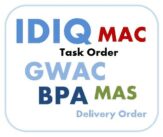You have probably heard about the upcoming multiple award contracts (MACs) on the horizon: NASA’s Government-wide Acquisition Contract (GWAC) SEWP V with the draft RFP already on the street, the somewhat controversial GSA’s OASIS, and even the Army’s ITES-3S possibly joining the ranks of multibillion-dollar vehicles. There are nearly 1,200 non-schedule MACs as of 2012, and their quantity has tripled since 2006, according to BGov analysts. Non-schedule MACs represent roughly 16 percent of Government procurement dollars, more than double the value of GSA schedules.
Total MAC spending has been steadily increasing despite a decrease in total procurement spending. Additionally, the 2008 National Defense Authorization Act requires all contracts with a potential value of at least $100 million to be awarded through MACs. In other words, more work is going to be awarded under MACs.
$4.1 billion in task orders expiring in the next three years will move to GSA’s Alliant and Alliant Small Business, with five task orders valued at more than $30 million each to be completed in this fiscal year, according to Brian Friel’s recent report on BGov.
If you don’t have the right portfolio of MACs, you won’t able to compete for the perfect contracts for your company.
Ironically, the competition pool is relatively small. Only about 3,600 companies out of hundreds of thousands of Government contractors participate in non-schedule MACs, and this number has stayed flat in the past few years.
All the MAC money goes to a small fraction of companies that understand the IDIQs’ advantage and know how to make money on the vehicles. Agencies keep selecting the same companies while they increase the number of competitors on their MACs.
If you are a small business, or a large business teaming with good small businesses, this is your time to master MACs to benefit from the current trends, because the Feds are awarding more and more work to small businesses under MACs, with double-digit annual percentage increases.
It also means that the companies who have learned “the system” for winning task orders on these vehicles will continue winning and growing their MAC footprint. Once you get on a MAC vehicle, you have to put a slew of measures in place to maximize your task order wins, or you won’t be able to catch up to those who have turned their proposal machines into “factories”. The current trend is that the average task order size is shrinking, which means more competition in a leaner, lower-margin environment. It is important that you know how to get more orders in a more efficient manner.
You will need to designate someone to actively develop the business to identify task order opportunities before they ever hit the street, and put together resources, processes, tools, and collateral to prepare highly competitive, page-limited proposals. Your system has to rely on the latest best practices to get ahead of your competitors.
IDIQs are hard to master and tend to require an initial investment before they begin making you money. They are worth it, though, because they can foster triple-digit growth, despite the sequestration and shrinking budgets.
Contact us to learn more.

